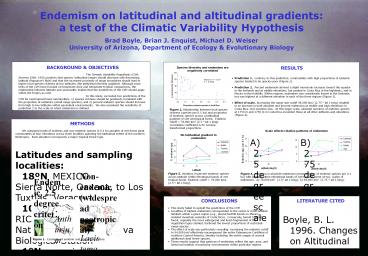Endemism on latitudinal and altitudinal gradients: - PowerPoint PPT Presentation
1 / 1
Title: Endemism on latitudinal and altitudinal gradients:
1
Endemism on latitudinal and altitudinal
gradients a test of the Climatic Variability
Hypothesis Brad Boyle, Brian J. Enquist, Michael
D. Weiser University of Arizona, Department of
Ecology Evolutionary Biology
BACKGROUND OBJECTIVES The Climatic
Variability Hypothesis (CVH Stevens 1989, 1992)
predicts that species latitudinal ranges should
decrease with decreasing latitude (Rapoports
Rule) and that the increased proximity of range
boundaries should lead to higher local species
richness at low latitudes (the latitudinal
diversity gradient). Although most tests of the
CVH have focused on temperate zone and
temperate-tropical comparisons, the relationship
between latitude and seasonality implies that the
predictions of the CVH should apply within the
tropics as well. In this study, we tested two
predictions of the CVH for neotropical forest
communities 1) species richness should be
positively correlated with the proportion of
endemics (small range species), and 2) percent
endemic species should increase from high to low
latitudes within equivalent environments. We
also examined the sensitivity of prediction 2 to
the scale at which endemism is defined.
Species diversity and endemism are negatively
correlated
Pearson r -0.57 P lt 0.0001
Figure 2. Relationship between local species
richness (species per 0.1 ha) and proportion of
endemic species across a latitudinal gradient of
wet neotropical forest. Endemic cutoff 78,000
km2 (2.5 º lat x long). Correlation coefficient
is for Arcsine-transformed proportions.
METHODS We compared totals of endemic and
non-endemic species in 0.1 ha samples of wet
forest plant communities at four elevations
across three localities spanning the latitudinal
extent of the northern Neotropics. Each
elevation corresponds a major tropical forest
type. Latitudes and sampling localities 18ºN M
EXICO Sierra Norte, Oaxaca, to Los Tuxtlas,
Veracruz 10ºN COSTA RICA Braulio Carrillo
Nationa Park and La Selva Biological
Station 1ºN ECUADOR NW slope of Andes, Volcan
Chiles to Rio Palenque Biological
Station Elevations and forest types sampled
Lowlands 100-150 m, Foothills 750 m, Middle
elevations 1750 m, Highlands 2750 m. Rainfall
at all locations ranged from 3500-6000 mm rainfal
per year. Species richness All plants ? 2.5
cm dbh per 0.1 ha. 1-3 samples per each
elevation x latitude combination. Plot
sources Lowlands (n 4 Los Tuxtlas, La
Selva, Rio Palenque), Gentry 1988 remaining
samples (n 37), Boyle 1996. Endemism 1.
Global distribution for all species encountered
determined using internet specimen databases
(TROPICOS, REMIB, INBio) supplemented with
taxonomic literature (Figure 1). 2.
Distributions classified as endemic or
non-endemic, at two scales of endemism 1)
Endemic ? 2.5 latitude x 2.5 longitude (?
78,000 km2 cf. Pitman et al. 1999) 2)
Endemic ? 2.75 latitude x 2.75 longitud (?
94,000 km2)
Figure 3. Variation in percent endemic species
across latitude within elevational bands of wet
tropical forest. Endemic cutoff 78,000 km2 (2.5
º lat x long).
- CONCLUSIONS
- This study failed to uphold the predictions of
the CVH - Localities of highest endemism corresponded to
the rarest or most isolated habitats within a
given region (e.g., pluvial foothill forests in
Mexico isolated mountain summits of Costa Rica).
Conversely, humid tropical forest, arguably the
most widespread and least-fragmented of the
vegetation types studied, harbored the lowest
proportions of restricted-range species. - The effect of scale was particularly revealing
increasing the endemic cutoff to 94,000 km2
effectively encompassed the entire Talamancan
Cordillera of southern Central America, thereby
including the entire ranges of several additional
cloud forest species. - These results suggest that patterns of endemism
reflect the age, area, and historical isolation
of particular environments within particular
regions.
LITERATURE CITED Boyle, B. L. 1996. Changes on
Altitudinal and Latitudinal Gradients in
Neotropical Montane Forests. Ph.D. Dissertation.
Washington University, St. Louis. Gentry, A. H.
1988. Changes in plant community diversity and
floristic composition on environmental and
geographical gradients. Annals of the Missouri
Botanical Garden 751-34. Pitman, N. C. A., J.
Terborgh, M. R. Silman, and P. Nuñez V. 1999.
Tree distributions in an upper Amazonian forest.
Ecology 802651-2661. Stevens, G. C. 1989. The
latitudinal gradient in geographic range how so
many species coexist in the tropics. The American
Naturalist 133240-256. Stevens, G. C. 1992. The
elevational gradients in altitudinal range an
extension of Rapoport's latitudinal rule to
altitude. The American Naturalist 140893-911.






























